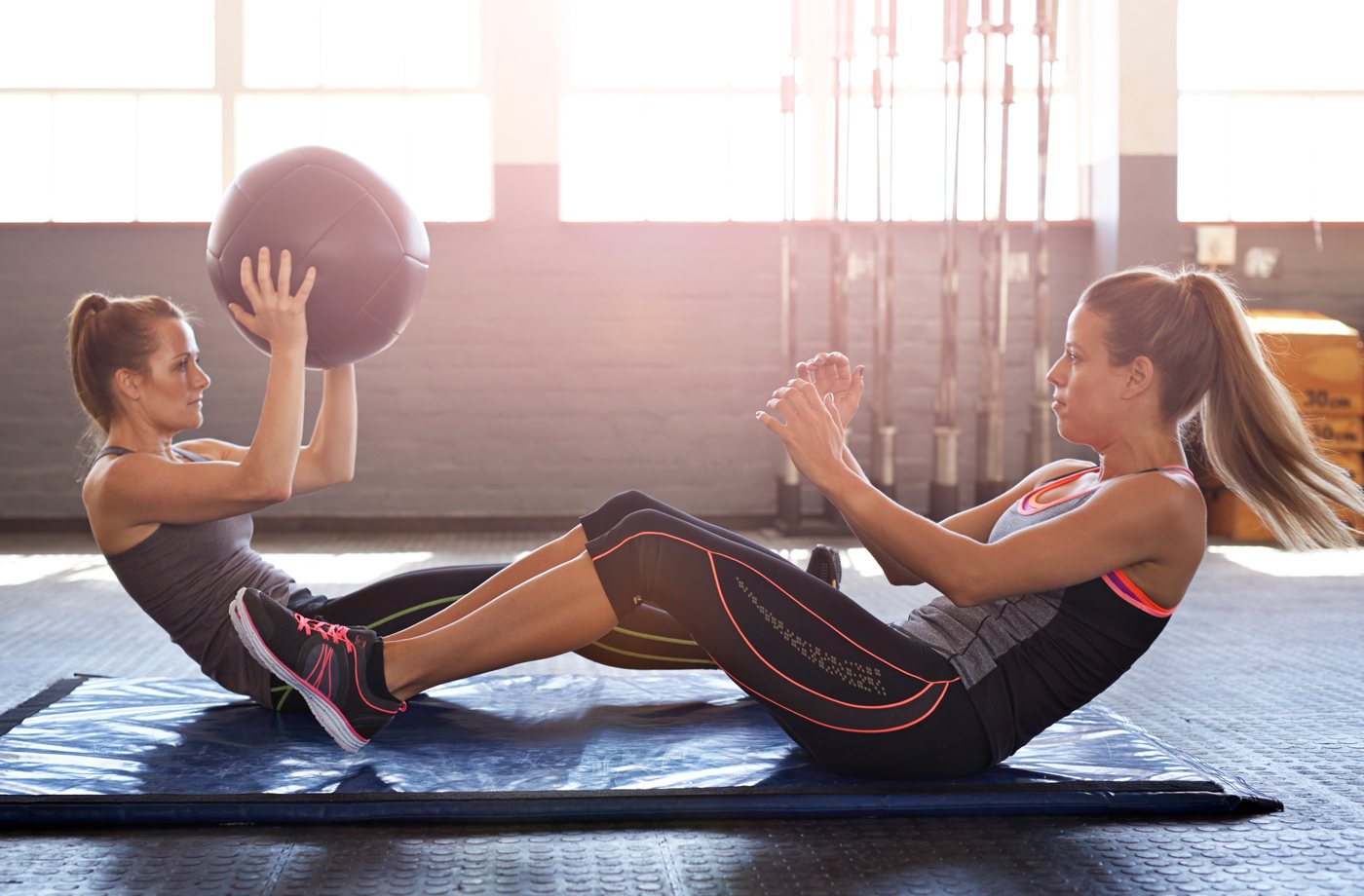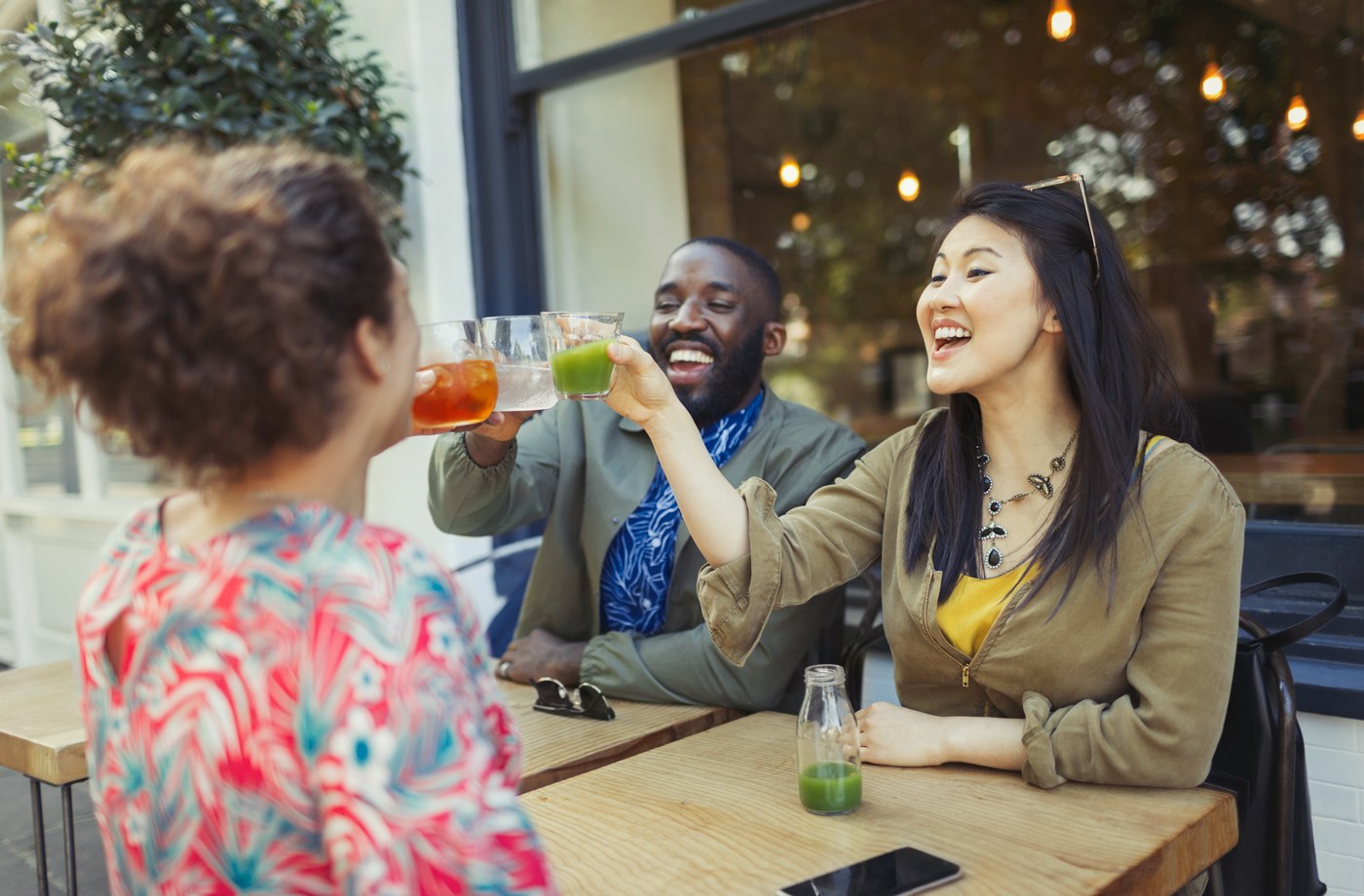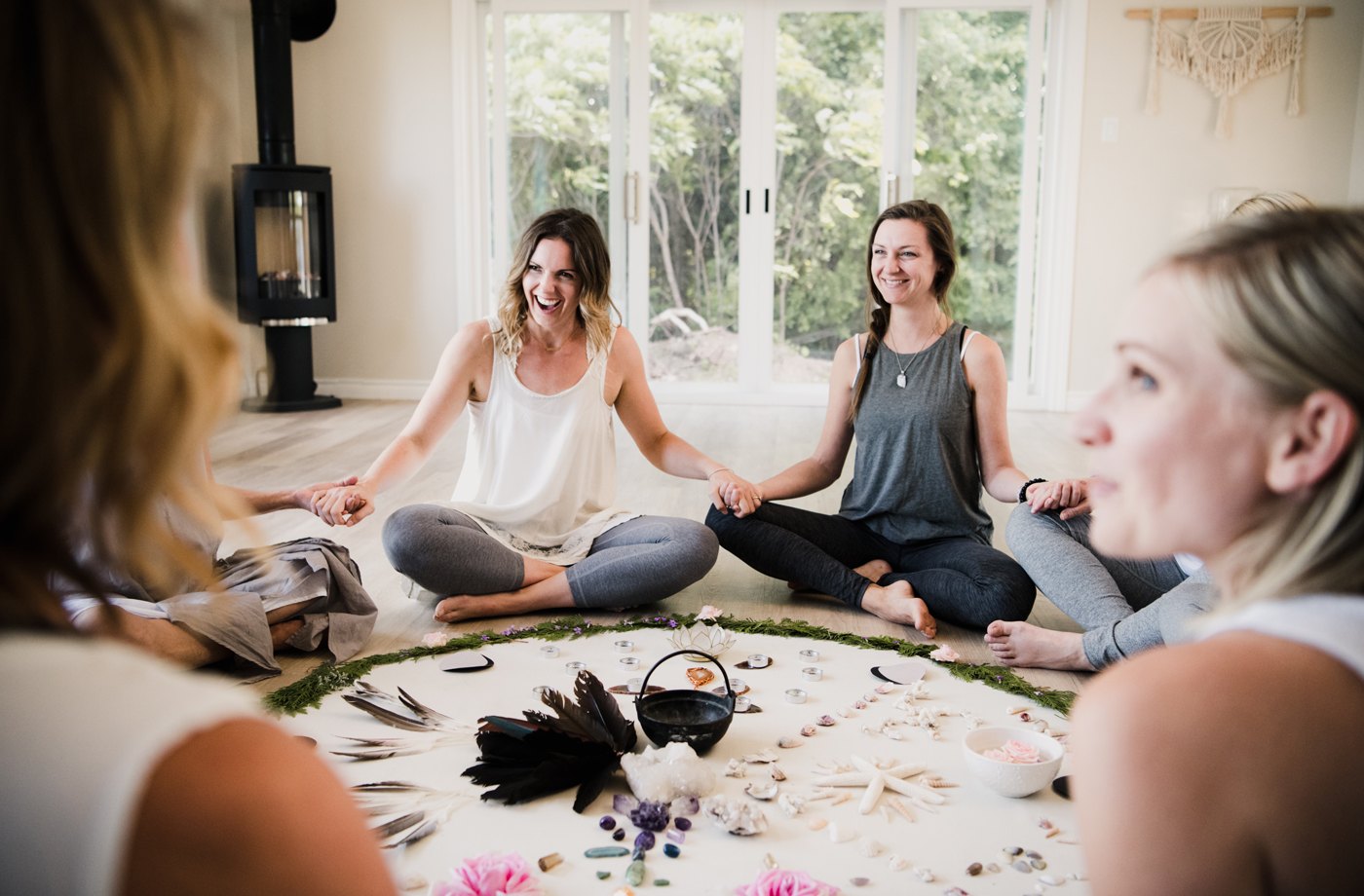Forget Bars and Malls: Why Wellness Spaces Have Become *the* Social Hangouts of Choice
This week on The Plus Factor, we’re talking about something that's crucial to our health and wellbeing: socializing. (Yes, we all need IRL bonding time with friends, no matter how loud the siren call of Netflix.) As a growing number of people dial back on bar hopping, fitness and wellness spaces are serving as the "third places" we're choosing to gather—and it's starting to change the way we relate.
Working out has always been an inherently social pursuit. Back in the '90s, leotard-clad moms would bond before class at Jazzercise, while my friends and I have been collecting gym crushes since the early '00s. (And I know we're not the only ones chatting up cute strangers on the treadmill.) Even so, when it came to spending quality time with friends and fam, fitness studios were never really the first place you'd think to go. I mean, consider how many Sex and the City storylines revolved around drinking Cosmos, eating brunch, and going shopping—and how so few involved sweating it out at yoga class.
But, as any gal who owns more leggings than going-out tops can attest, that's no longer the case. Now, gyms and other wellness spaces are becoming the third places of choice for professional millennial women, in particular—that's to say, they're the social spaces where we gather when we're not at work or at home. (Sociologist Ray Oldenburg popularized the phrase "third place" in the 1980s, as a way of referring to bars, malls, religious institutions, clubs, nail salons, and the like.) Think about it: Aren't you meeting friends for barre classes or new moon circles more now than you did, say, five years ago? (If you even did at all?)

{{post.sponsorText}}
This shift is happening at a time when several classic 20- and 30-something social activities are on the decline. Hitting the bar scene is one of them. A 2017 Nielsen study showed that millennials are less likely to drink alcohol than their parents and older siblings—only 53 percent surveyed said that they'd had an adult beverage in the past month, compared to 65 percent of Gen X-ers and 72 percent of Baby Boomers. This isn't just happening in the U.S., either. A Guardian article, titled "Millennials Make it a Slow Booze Summer in the U.K.," revealed that 47 percent of British millennials consider getting drunk to be "uncool", while more than a quarter of 16-24 year olds are choosing not to drink at all.
"Millennials are a generation fascinated by self-actualization, self-improvement, and community—and in finding spaces that enable them to experience all those things together." —Christina Disler, founder of Werklab
So since they're less likely to be hungover on Sunday morning, are younger adults hitting up houses of worship instead? Not exactly. Church attendance is also on the decline, according to Gallup data, and Pew Research's 2014 Religious Landscape Study showed that only about 25 percent of millennials attend religious services on a weekly basis—down about 10 percent from 2007.
Even retail therapy isn't doing it for us anymore, at least not in the traditional sense. One in four U.S. shopping malls are likely to close within the next five years, according to Credit Suisse, due largely in part to the fact that we're all shopping online. (And, usually, alone.)
But thankfully, the rapidly growing ranks of CrossFit boxes, group meditation studios, and matcha cafés are here to step in. And, in a lot of ways, they really do fulfill the same roles as the once-dominant third places that came before them.
"Millennials are a generation fascinated by self-actualization, self-improvement, and community—and in finding spaces that enable them to experience all those things together," says Christina Disler, founder of Werklab, a coworking space in Vancouver that emphasizes personal development and holistic wellness. "Where churches used to fill the spiritual growth desire, people are seeking autonomy in their thoughts, beliefs, and lifestyles. Where bars used to fulfill the desire for connection and community, people are interested in more than simply bantering over a beer or two. While technology has us more accessible and connected in some ways, it’s left people lonelier than ever. Wellness spaces are filling that gap."
Think of them as this generation's version of Cheers—where everybody knows your name. (And your food blog's Insta handle.)
Read on to find out why happy hour is starting to involve fewer cocktails and more cardio.

Why our social lives are now revolving around wellness
Boozing and Bible study may be taking up less space on our calendars, but wellness is unquestionably booming. According to the Global Wellness Institute, the world's wellness economy is currently worth $4.2 trillion, spiking nearly 7 percent over the past two years alone. Surely, more than a few Thirsty Thursday bar budgets have been diverted to the cause—but why?
"I think there are a few dimensions to this shift," says Michelle Pellizzon, founder of inclusive wellness community Holisticism. "First, I think that most millennials are always looking to optimize their time—it feels like there is so little of it these days. If we can get a workout in and catch up with our girlfriends, it feels like we're killing two birds with one stone. [Even] if we're working out next to each other and not really catching up."
Then there's the fact that millennials are obsessed with sharing their passions and discoveries—and there are a lot of cool, double-tappable things happening on the wellness scene these days, from mass meditation festivals to fitness studio crawls. Pellizzon's experienced this firsthand, both at the events she hosts for Holisticism and in her own life. "I recently attended an event here in LA called The Outernet that totally blew me away, and I am trying to bring all my pals to the next one because it was so unique and special," she says. "After, we're planning on catching up and grabbing dinner. I'm guessing that we'll probably swing by a vegan-friendly spot with kombucha on tap, because who wants to undo the natural high we'll have from The Outernet with booze?"
"The more people are investing, in terms of time and money, in their overall wellbeing, the less sense it makes to throw it all away over Friday night cocktails."—Ruby Warrington, author of Sober Curious
Ruby Warrington, author of forthcoming book Sober Curious, and founder of The Numinous and alcohol-free social event series Club SÖDA NYC, hears this kind of reasoning all the time in her circle. "The more people are investing, in terms of time and money, in their overall wellbeing, the less sense it makes to throw it all away over Friday night cocktails. Especially if you wanna feel fresh for your favorite weekend yoga class, for example," she says. "Thanks to technology and social media, we're living in an 'always on' culture—and booze leaves us feeling even more wired and tired. Whereas a lot of wellness offerings are about calming the mind and body, and inviting in a genuine sense of relaxation."
Bonus points if your night out also allows you to connect with your higher power, however you define it. (Think Angela Davis' sermon-style SoulCycle classes in Los Angeles, or the personal development-themed dance, yoga, and workshop offerings at Knockout, an LA studio that emphasizes self-discovery over six-packs.)

How third places are evolving for the wellness revolution
While we've seen lots of wellness-driven experiences crop up specifically to create a connection among millennials—like Holisticism, Hello Wellness, and Wellvyl—traditional healthy-living spaces are also shifting in a more social direction. One prime example is Trufusion, a new boutique fitness chain with locations in eight states. The brand is totally tuned into this demographic: It's affordable (unlimited memberships in many cities are under $100 a month), it offers Classpass-style variety (65 types of classes are on offer at each location), and it fosters a sense of community.
"Our studios are built to facilitate that social aspect—we have a smoothie bar and an area for people to sit and talk, and they do," says the brand's chief marketing officer, Steve Rockman. "You don’t see anyone with headphones in or a baseball hat over their face not wanting to engage with everybody." According to Rockman, members visit their home studio three to four times a week, on average—above the industry standard—with some doing two to three classes a day. "A lot of people are using it as a social space," he says. "We have an unusual amount of people who come with friends."
Even other types of third places are becoming more focused on wellness. Take Werklab, for example—while it started out as being a traditional membership club and coworking space for young professionals, Distler eventually brought holistic health programming into the mix once she saw what a difference it made in her own life. "We aim to give members access to multiple modalities for caring for themselves," she explains. "This involves everything from quiet corners and meditation cushions to daily movement classes and in-house reiki practitioners, expert-led workshops in neuroscience to mediumship and channeling, and a whole lot of things in between." And because of this, members often stick around to hang out well after they've powered down their laptops.

The future of wellness communities as third places
To be clear, just because healthy third places are on the rise doesn't mean we're giving up our old social habits altogether. Plenty of women are still meeting for movie dates, pizza dinners, and PSLs in the park, and that won't ever change. The difference is, now, those aren't our only options, and wellness is becoming a more important part of the mix.
"From what our members tell me, they're really trying to strike a healthy, normal balance between wellness and real life," says Pellizzon. "We're all trying to optimize and live the best versions of our lives—sometimes that means treating yourself to a detox bath with crystals and candles and binaural beats playing in your ears, and sometimes that means grabbing a glass of wine with your best friends."
For this reason, Warrington predicts that nightlife and wellness will start to merge in the future. "I think we'll see more spaces for people to hang after classes, with elixir bars, evening-style lighting, and music, as opposed to brightly lit lobby spaces which are designed to get people in and out as fast as possible," she says. "I also foresee more and more creative programing that mimics standard nightlife offerings, such as Kundalini disco, ecstatic dance, story medicine circles, and other 'wellness' experiences that invite social interactions."
"From what our members tell me, they're really trying to strike a healthy, normal balance between wellness and real life."—Michelle Pellizzon, founder of Holisticism
TruFusion's already doing this—the brand recently hosted a speed-dating workout event with OKCupid, and its studios often host live musicians and DJs in the classrooms and common areas. "We're trying to create that entertainment value," says Rockman.
Pellizzon, on the other hand, envisions these healthy third places making their way into our first places—our homes. (Hey, staying in is the new going out.) "I think that we're really going to see people recreate these events and spaces in their own homes with their own communities," she says. "Like everything, wellness spaces will go virtual. I can imagine women learning how to hold their own moon circles and sound baths in their apartments with their friends, where they can truly customize the experience to reflect what they love."
But no matter what the future holds, the end goal of the third place will remain unchanged. "Ultimately, when we're looking for ways to socialize and unwind outside of work hours, it's about choosing activities that make us feel good and give us the opportunity to connect with others," says Warrington. And the more options we have to do so, the better.
This 24-year-old writer proves it's possible to not drink and have a healthy social life. It's even possible to—gasp—flirt while sober (and not be awkward.)
Loading More Posts...